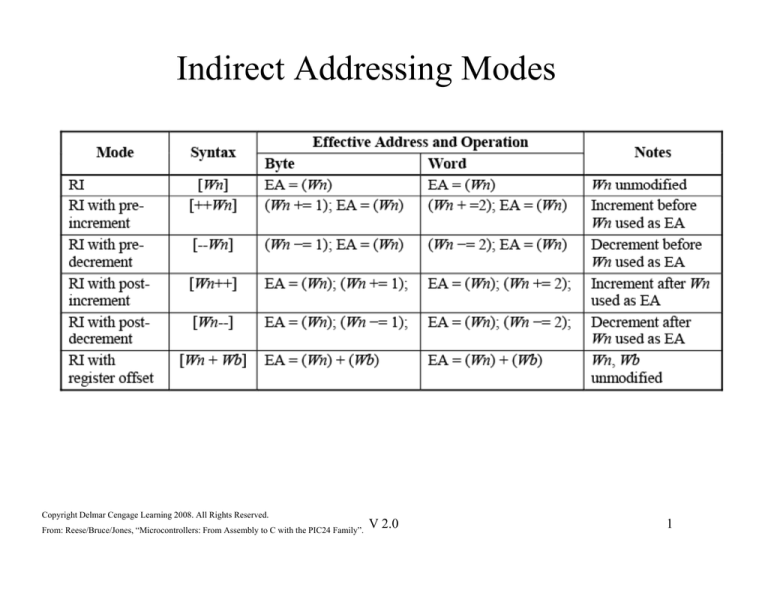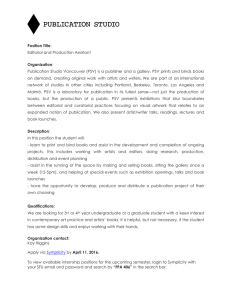
Indirect Addressing Modes
Copyright Delmar Cengage Learning 2008. All Rights Reserved.
From: Reese/Bruce/Jones, “Microcontrollers: From Assembly to C with the PIC24 Family”.
V 2.0
1
Indirect Addressing Modes Examples
Copyright Delmar Cengage Learning 2008. All Rights Reserved.
From: Reese/Bruce/Jones, “Microcontrollers: From Assembly to C with the PIC24 Family”.
V 2.0
2
Register Indirect with Register Offset Examples
Copyright Delmar Cengage Learning 2008. All Rights Reserved.
From: Reese/Bruce/Jones, “Microcontrollers: From Assembly to C with the PIC24 Family”.
V 2.0
3
Arrays and Pointers in C
• A pointer variable is a variable that contains the
address of another variable.
• An array is a collection of like elements, such as
an array of integers, array of characters, etc.
• One use of pointer variables in C is for stepping
through the elements of an array.
• Another use of pointer variables is for passing
arrays to subroutines
– O
Only
l have
h
tto pass the
th address
dd
off the
th first
fi t element
l
t
instead of passing all of the array elements!
V 2.0
4
A First Look at C Pointers
& is “address of” operator, “*” is dereference operator.
Pointers to data RAM are 16-bits wide because there are 64Ki
addressable locations.
Copyright Delmar Cengage Learning 2008. All Rights Reserved.
V 2.0
From: Reese/Bruce/Jones, “Microcontrollers: From Assembly to C with the PIC24 Family”.
5
Same Example with uint32 variables
p is still 16
16-bits!
bits! Pointer size is always 16 bits,
bits not dependent upon referenced
data size
Copyright Delmar Cengage Learning 2008. All Rights Reserved.
V 2.0
From: Reese/Bruce/Jones, “Microcontrollers: From Assembly to C with the PIC24 Family”.
6
uint16* Pointer Example to Assembly
In C
uint16 u16_k, u16_j;
uint16* pu16_a;
In Assembly
u16_k: .space 2
u16_j: .space 2
;; W1 is used for pu16_a
(1) u16_k = 0xA245;
(2) u16_j
16 j = 0x9FC1;
0 9FC1
(3) pu16_a = &u16_j;
(4) u16_k = *pu16_a;
mov #0xA245,W0
mov W0,u16_k
;u16_k = 0xA245
mov #0x9FC1,W0
mov W0,u16_j
;u16_j = 0x9FC1
mov #u16_j,W1
;W1 = &u16_j
mov [W1],W0
mov W0,u16
,
_k
;W0 = *W1 = *pu16_a = u16_j
;
;u16_k = W0 = u16_j
j
W1 register used to implement the pu16_a pointer.
Indirect addressing used to implement *pu16_a.
Copyright Delmar Cengage Learning 2008. All Rights Reserved.
From: Reese/Bruce/Jones, “Microcontrollers: From Assembly to C with the PIC24 Family”.
V 2.0
7
Pointers in assembly
Operation
RTL
Assembly
C
Literal
____
0x0900 → W0
#
mov #0x0900, W0
mov #u8_c, W0
mov W0, pu8_b
mov #au8_d, W0
mov W0,
W0 pu8_b
pu8 b
____ (based on type)
W0 = 0x0900;
pu8_b = &u8_c;
=> pu8_b = 0x0804;
pu8_b = au8_d;
=>
> pu8_b
pu8 b = 0x0805;
Direct
(___)
(u16_a) → W0
=> ((0x0800)) → W0
____
mov u16_a, W0
=> mov 0x0800,, W0
____ (based on type)
W0 = u16_a;
(Register)
indirect
((___))
((pu8_b)) → W0
((0x0802)) → W0
[___] (registers only)
mov pu8_b, W1
mov [W1], W0
*____ or ____[0]
W0 = *pu8_b; // or
W0 = pu8_b[0]
.space u16_a
.space pu8_b
.space u8_c
.space au8_d
2 ; u16_a = 0x0800
2 ; pu8_b = 0x0802
1 ; u8_c = 0x0804
10 ; au8_d = 0x0805
Address
0x0800
0x0802
0x0804
Data
0x1234
0x0804
0x5678
uint32* Pointer Example to Assembly
Copyright Delmar Cengage Learning 2008. All Rights Reserved.
From: Reese/Bruce/Jones, “Microcontrollers: From Assembly to C with the PIC24 Family”.
V 2.0
9
Pointer Arithmetic
Pointer arithmetic means to add or subtract a pointer by some value. The
value
l being
b i added
dd d to
t the
th pointer
i t or subtracted
bt t d from
f
the
th pointer
i t is
i multiplied
lti li d
by the SIZE in bytes of what the pointer is pointing at!
uint8*
uint8
pu8_a;
u8_j,
u8 j u8_k;
u8 k;
pu8_a = &u8_j;
pu8_a = pu8_a + 1;
uint16*
uint16
pu16_a;
u16_j,u16_k;
pu16_a
pu16
a = &u16
&u16_j;
j;
pu16_a = pu16_a + 1;
uint32
uint32*
uint32
; pu8_a = pu8_a + 1*sizeof(uint8)
; pu8_a = pu8_a + 1*1 = pu8_a + 1;
; pu16_a = pu16_a + 1*sizeof(uint16)
; pu16_a = pu16_a + 1*2 = pu16_a + 2;
pu32_a;
pu32
a;
u32_j,u32_k;
pu32_a = &u32_j;
pu32_a = pu32_a + 1;
; pu32_a = pu32_a + 1*sizeof(uint32)
32
= pu32_a
32
+ 1
1*4 = pu32_a
32
+ 4;
; pu32_a
V 2.0
10
Pointer Arithmetic (continued)
Pointer arithmetic means to add or subtract a pointer by some value. The
value
l being
b i added
dd d to
t the
th pointer
i t or subtracted
bt t d from
f
the
th pointer
i t is
i multiplied
lti li d
by the SIZE in bytes of what the pointer is pointing at!
uint8*
int8*
uint8
pu8_a;
p 8 a
u8_j, u8_k;
pu8_a = &u8_j;
pu8_a
_ = pu_a
_ + 1;
uint16*
uint16
;use W1 for pu8_a
;pu8_a = pu8_a + 1*sizeof(uint8)
;pu8 a = pu8_a
;pu8_a
pu8 a + 1*1 = pu8_a
pu8 a + 1;
pu16_a;
u16_j,u16_k;
pu16_a = &u16_j;
pu16_a = pu_a + 1;
uint32*
uint32
mov #u8_j, W1
add W1,#1, W1
mov #u16_j, W1
add W1,#2, W1
;use W1 for pu16_a
;pu16_a = pu16_a + 1*sizeof(uint16)
;pu16_a = pu16_a + 1*2 = pu16_a + 2;
mov #u32_j, W1
add W1,#4, W1
;use W1 for pu32_a
;pu32_a
_ = pu32_a
_ + 1*sizeof(uint32)
;pu32_a = pu32_a + 1*4 = pu32_a + 4;
pu32_a;
u32_j,u32_k;
pu32_a = &u32_j;
pu32 a = pu
pu32_a
pu_a
a + 1;
V 2.0
11
Arrays and Pointers: Array of uint8
Copyright Delmar Cengage Learning 2008. All Rights Reserved.
From: Reese/Bruce/Jones, “Microcontrollers: From Assembly to C with the PIC24 Family”.
V 2.0
12
Arrays and Pointers: Array of uint16
Copyright Delmar Cengage Learning 2008. All Rights Reserved.
From: Reese/Bruce/Jones, “Microcontrollers: From Assembly to C with the PIC24 Family”.
V 2.0
13
Add two uint16 Arrays
Copyright Delmar Cengage Learning 2008. All Rights Reserved.
From: Reese/Bruce/Jones, “Microcontrollers: From Assembly to C with the PIC24 Family”.
V 2.0
14
C Strings
Copyright Delmar Cengage Learning 2008. All Rights Reserved.
From: Reese/Bruce/Jones, “Microcontrollers: From Assembly to C with the PIC24 Family”.
V 2.0
15
The repeat Instruction
Copyright Delmar Cengage Learning 2008. All Rights Reserved.
From: Reese/Bruce/Jones, “Microcontrollers: From Assembly to C with the PIC24 Family”.
V 2.0
16
Why are Subroutines needed?
Copyright Delmar Cengage Learning 2008. All Rights Reserved.
From: Reese/Bruce/Jones, “Microcontrollers: From Assembly to C with the PIC24 Family”.
V 2.0
17
A C Subroutine (Function)
Copyright Delmar Cengage Learning 2008. All Rights Reserved.
From: Reese/Bruce/Jones, “Microcontrollers: From Assembly to C with the PIC24 Family”.
V 2.0
18
Call/Return
Copyright Delmar Cengage Learning 2008. All Rights Reserved.
From: Reese/Bruce/Jones, “Microcontrollers: From Assembly to C with the PIC24 Family”.
V 2.0
19
A Stack
Copyright Delmar Cengage Learning 2008. All Rights Reserved.
From: Reese/Bruce/Jones, “Microcontrollers: From Assembly to C with the PIC24 Family”.
V 2.0
20
Push/Pop on PIC24 Stack
mov src, [W15++]
mov [--W15], dest
Copyright Delmar Cengage Learning 2008. All Rights Reserved.
From: Reese/Bruce/Jones, “Microcontrollers: From Assembly to C with the PIC24 Family”.
V 2.0
21
Push/Pop Forms
Copyright Delmar Cengage Learning 2008. All Rights Reserved.
From: Reese/Bruce/Jones, “Microcontrollers: From Assembly to C with the PIC24 Family”.
V 2.0
22
Push/Pop Example
Copyright Delmar Cengage Learning 2008. All Rights Reserved.
From: Reese/Bruce/Jones, “Microcontrollers: From Assembly to C with the PIC24 Family”.
V 2.0
23
New instructions: call/rcall, return
The call/rcall instructions can used to call a subroutine.
The call instruction is 2 program words, the rcall is 1
program word.
word Each does the same two things:
1. Pushes the return address on the stack. The return
address is the address of the instruction after the
call/rcall
ll/
ll instruction.
instr ction
2. Does an unconditional jump to the subroutine.
The return instruction is used to return from a subroutine. It
pops the top of the stack into the program counter, causing a
j
jump
to that
h location.
l
i Under
d normall conditions,
di i
the
h value
l
popped from the stack will be the return address for the
call/rcall instruction used to jjumpp to this subroutine.
Copyright Delmar Cengage Learning 2008. All Rights Reserved.
From: Reese/Bruce/Jones, “Microcontrollers: From Assembly to C with the PIC24 Family”.
V 2.0
24
Call/Return and the Stack
Copyright Delmar Cengage Learning 2008. All Rights Reserved.
From: Reese/Bruce/Jones, “Microcontrollers: From Assembly to C with the PIC24 Family”.
V 2.0
25
Call/Return Forms
Copyright Delmar Cengage Learning 2008. All Rights Reserved.
From: Reese/Bruce/Jones, “Microcontrollers: From Assembly to C with the PIC24 Family”.
V 2.0
26
Dynamic Allocation
f Locals
for
L l
Dynamic allocation
is needed for
recursive functions
to operate correctly.
New space for
parameters and
locals are allocated
in registers or on the
stack.
Copyright Delmar Cengage Learning 2008. All Rights Reserved.
From: Reese/Bruce/Jones, “Microcontrollers: From Assembly to C with the PIC24 Family”.
V 2.0
27
Rules For Subroutine Parameter Passing
• W0-W7 are used for parameters, left to right order. W0-W7 are
caller saved (if caller wants these preserved,
preserved caller has to save
them).
• Function values returned in W0-W3 (W0 for 8/16 bit, W0-W1
f 32-bit,
for
32 bit W0-W3
W0 W3 for
f 64-bit
64 bit values).
l )
• Registers W8-W14 are callee saved (if the callee uses them,
must be preserved).
• Locals are allocated to unused W0-W7 registers, and also to W8W14.
Copyright Delmar Cengage Learning 2008. All Rights Reserved.
From: Reese/Bruce/Jones, “Microcontrollers: From Assembly to C with the PIC24 Family”.
V 2.0
28
Subroutine Example
Copyright Delmar Cengage Learning 2008. All Rights Reserved.
From: Reese/Bruce/Jones, “Microcontrollers: From Assembly to C with the PIC24 Family”.
V 2.0
29
Subroutine Call Example
Copyright Delmar Cengage Learning 2008. All Rights Reserved.
From: Reese/Bruce/Jones, “Microcontrollers: From Assembly to C with the PIC24 Family”.
V 2.0
30
Usingg the stack to save register
g
values
Recall the countOnes() PIC24 implementation used the W1, W2
registers for local variables. What if the caller wanted to save
these
h
registers?
i
? Push
P h them
h on the
h stackk before
b f
call,
ll then
h pop
them off (must be in reverse order of push!!!)
push W1
push W2
p
mov u16_k, WREG
rcall countOnes
mov b WREG,
mov.b
WREG u8
u8_j
j
pop W2
pop W1
;save W1
;save W2
;pass u16_k in W0
;call the function
;save return value
;restore W2
;restore W1
V 2.0
31
A Recursive Subroutine
Observe that stack is used for temporary storage.
Copyright Delmar Cengage Learning 2008. All Rights Reserved.
From: Reese/Bruce/Jones, “Microcontrollers: From Assembly to C with the PIC24 Family”.
V 2.0
32
Subroutine with Multiple Parameters
Copyright Delmar Cengage Learning 2008. All Rights Reserved.
From: Reese/Bruce/Jones, “Microcontrollers: From Assembly to C with the PIC24 Family”.
V 2.0
33
Global Variable Initialization
Copyright Delmar Cengage Learning 2008. All Rights Reserved.
From: Reese/Bruce/Jones, “Microcontrollers: From Assembly to C with the PIC24 Family”.
V 2.0
34
What does ‘init_variables’ do?
• Initial values for variables live in program memory which is
non-volatile.
• Can use a special mode called program space visibility (PSV)
that allows upper half of memory to be mapped to program
memory.
• Can
C then
th use instructions
i t ti
to
t copy data
d t from
f
program memory to
t
data memory to initialize variables.
Copyright Delmar Cengage Learning 2008. All Rights Reserved.
From: Reese/Bruce/Jones, “Microcontrollers: From Assembly to C with the PIC24 Family”.
V 2.0
35
(1) .text ;program memory
(2) ;; constant data to be moved to data memory
(3) sz_1_const: .asciz "Hello"
(4) sz_2_const:
2
.asciz
i "UPPER/l
"UPPER/lower""
(5) init_variables:
(6) ;turn on program visibility space, use default PSVPAG value of 0
((7)) bset CORCON,#2
,
;;enable PSV
(8) ;copy source address in program memory to W2
(9) mov #psvoffset(sz_1_const),W2
(10) mov #sz_1,W3
;destination address in data memory
(11) rcall copy_cstring
(12);copy source address in program memory to W2
(13) mov #psvoffset(sz_2_const),W2
(14) mov #sz_2,W3
;destination address in data memory
(15) rcall copy_cstring
(16) return
(17);;copy constant null-terminated string from program memory to data memory
(18);;W2 points to program memory, W3 to data memory
(19) copy_cstring:
(20) mov.b [W2],W0
(21) cp
cp.bb W0,#0
W0 #0
;test for null byte
(22) bra Z, copy_cstring_exit ;exit if null byte
(23) mov.b [W2++],[W3++]
;copy byte
(24) bra copy_cstring
;loop to top
(25) copy_cstring_exit:
(26) mov.b
b [[W2++],[W3++]
2 ][ 3 ]
;copy null
ll byte
b
(27) return
V 2.0
I it
Init_variables
i bl
Copy strings
from
program
memory to
d memory
data
36
Local variables versus gglobal variables
• Global variables are assigned fixed memory locations in data
memory by the compiler (i.e,
(i e 0x800,
0x800 0x802,
0x802 etc).
etc)
• Local variables (variables declared in subroutines) are assigned
either to working registers or to space allocated on the stack.
• Allocation
All ti off stack
t k space for
f local
l l variables
i bl is
i called
ll d a stack
t k
frame, and is an advanced topic that is not covered in this
class (but is covered in the book and other slides). Stack
frames can also be used to pass parameters to functions.
• In our PIC24 implementations of C functions for homework
or test problem examples,
examples we will always use working
registers for local variables declared in subroutines, and we
will always use working registers to pass parameters to
subroutines.
b ti
V 2.0
37
Stack Frames
Used when cannot fit locals, parameters in registers.
Use the stack for storage
storage.
Copyright Delmar Cengage Learning 2008. All Rights Reserved.
From: Reese/Bruce/Jones, “Microcontrollers: From Assembly to C with the PIC24 Family”.
V 2.0
38
Constructing a Stack Frame
Copyright Delmar Cengage Learning 2008. All Rights Reserved.
From: Reese/Bruce/Jones, “Microcontrollers: From Assembly to C with the PIC24 Family”.
V 2.0
39
Stack Frame for fib() Function
Copyright Delmar Cengage Learning 2008. All Rights Reserved.
From: Reese/Bruce/Jones, “Microcontrollers: From Assembly to C with the PIC24 Family”.
V 2.0
40
Calling fib()
Copyright Delmar Cengage Learning 2008. All Rights Reserved.
From: Reese/Bruce/Jones, “Microcontrollers: From Assembly to C with the PIC24 Family”.
V 2.0
41
fib() Implementation
fib() with stack
frames required
20 instructions,
without stack
frames only 15
instructions.
The generality
of stack frames
has overhead
costs.
Copyright Delmar Cengage Learning 2008. All Rights Reserved.
From: Reese/Bruce/Jones, “Microcontrollers: From Assembly to C with the PIC24 Family”.
V 2.0
42
What do you have to know?
• Indirect addressing modes for PIC24
• C code operation with pointers and arrays
• Implementation of C code with pointers/arrays in
PIC24 assembly
assembly.
• How the stack on the PIC24 works
• How subroutine call/return works with the PIC24 stack
• How to pass parameters to a subroutine using registers
for parameters and locals
• How to implement small C functions in PIC24
assembly.
V 2.0
43





